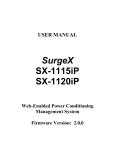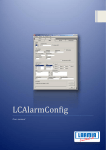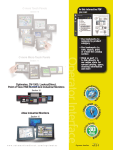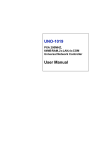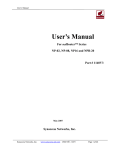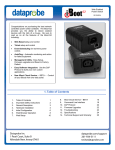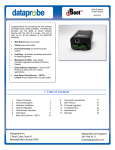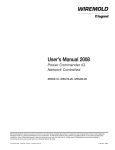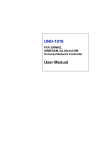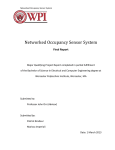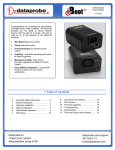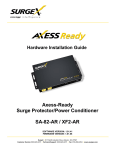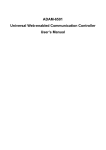Download SX1120iP Manual
Transcript
USER MANUAL SurgeX SX-1115ip-X SX-1120ip-X Web-Enabled Power Conditioning Management System Software Version: vQ110630G.123 Firmware Version: Q110630G.285 0 iControl Manual INTRODUCTION......................................................................................................................... 3 INITIAL SET-UP.......................................................................................................................... 5 SETUP AND CONTROL UTILITY (SCU) ............................................................................................. 5 COMMAND LINE INTERFACE (CLI) .................................................................................................. 6 SETTING THE IP ADDRESS ............................................................................................................... 6 INSTALLATION .......................................................................................................................... 9 120 VOLT CONNECTIONS .................................................................................................................. 9 ETHERNET CONNECTION .................................................................................................................. 9 RS232 (SERIAL) PORT CONNECTION .................................................................................................. 9 DIAL LINE ........................................................................................................................................ 9 EXPANSION ...................................................................................................................................... 9 LED INDICATORS .................................................................................................................... 10 WEB SERVER ............................................................................................................................ 10 HEADER ......................................................................................................................................... 10 CONTROL ....................................................................................................................................... 11 STATUS .......................................................................................................................................... 11 DEVICE VIEW ................................................................................................................................. 11 OUTLET STATUS ............................................................................................................................ 12 GROUP VIEW.................................................................................................................................. 12 GLOBAL VIEW ............................................................................................................................... 12 AUTOPING VIEW............................................................................................................................ 13 COMMAND LINE INTERFACE (CLI) PROTOCOL .......................................................... 14 OUTLET COMMANDS ...................................................................................................................... 14 USER COMMANDS .......................................................................................................................... 15 DEVICE COMMANDS ...................................................................................................................... 16 GROUP COMMANDS ....................................................................................................................... 18 NETWORK COMMANDS .................................................................................................................. 19 WEB SERVER COMMANDS ............................................................................................................. 19 TELNET COMMANDS ...................................................................................................................... 19 AUTOPING COMMANDS ................................................................................................................. 20 EVENT COMMANDS ........................................................................................................................ 20 EMAIL COMMANDS ........................................................................................................................ 21 TIME COMMANDS .......................................................................................................................... 22 FIRMWARE UPLOAD COMMANDS ................................................................................................... 22 1 iControl Manual ADVANCED OPERATION ...................................................................................................... 23 DTMF CONTROL ........................................................................................................................... 23 TIMED EVENTS............................................................................................................................... 24 AUTOPING ..................................................................................................................................... 25 SSL SECURITY ............................................................................................................................... 26 CERTIFICATE UPLOAD UTILITY ....................................................................................... 27 EMAIL NOTIFICATION .......................................................................................................... 28 SNMP ........................................................................................................................................... 29 FIRMWARE UPGRADES ........................................................................................................ 29 FRONT PANEL RESET BUTTON .......................................................................................... 29 SETUP AND CONTROL UTILITY (SCU) ............................................................................. 30 SNMP MIB .................................................................................................................................. 31 COMPLIANCE STATEMENTS .............................................................................................. 32 SPECIFICATIONS..................................................................................................................... 33 2 iControl Manual INTRODUCTION The SurgeX® iControl SX-1115ip-X (SX-1120ip-X) is a single rack-space, 120V, 15 (20) amp, AC power conditioner that can be controlled over a network or the internet. The iControl incorporates SurgeX Advanced Series Mode® power conditioning and surge elimination, as well as SurgeX Impedance Tolerant® EMI/RFI filtering. The simple web server structure allows basic control of the outlets (and groups of outlets) and viewing of status information all from the home page. The extensive programming and setup capabilities are accessed by a Setup and Control Utility (SCU) or through a Command Line Interface (CLI). Telnet and serial access use the same Command Line Interface (CLI) structure and syntax to completely configure the iControl, or multiple iControls in a cluster configuration. Up to 16 iControls can be linked together and controlled from a single web or CLI interface. One master iControl provides the communication to the users and continuously receives status information from the rest of the iControls in the cluster. Up to 128 outlets can be controlled in this manner from one IP address. Multiple outlets, across multiple iControls in clustered configurations, can be linked together in named groups and managed together. This allows, for example, power cycling all devices of a certain type together. Up to 16 systems can be continuously monitored with AutoPing, with automatic power control upon loss of contact. Reboot crashed systems, or provide auto power-up or –down for environmental controls and notification systems. Up to 16 users can be assigned administrator or user only rights, plus access to specific outlets and groups. Users only see the outlets and groups they are assigned to. The eight rear-mounted receptacles can each be individually controlled. The metering includes the AC line voltage and total current draw. Located on the rear panel are the input power cord, circuit breaker (15A or 20A), 8 NEMA 5-15 AC outlets, Serial connection (DCE, 9 pin D-subminiature), Network connection (RJ-45), Phone connection (RJ-11), and Expansion Ports for cluster configurations. 3 iControl Manual The two front panel LEDs provide indication of AC power (red) and surge protection status (green). Also located on the front panel is a recessed Reset button (used to reset the Administrator password). The extensive programming capabilities of the iControl allow sequencing and scheduling to be set up, not just for the host unit, but also for other iControl units on the same network. The internal modem (for models with internal modem option) supports data calls from terminal devices using the CLI, and direct dial from a tone telephone for simple On/Off control when more sophisticated means are not available. Setup and Control functions can be linked to any SNMP v1 compatible manager. The iControl MIB is available at surgex.com. All activity can be reported to a syslog compatible server. The iControl’s internal web server is secured with Secure Sockets Layer (SSL) encryption. The iControl’s Certificate Utility can be used to create, manage, and upload SSL certificates. 4 iControl Manual INITIAL SET-UP Setup and Control Utility (SCU) The iControl Setup and Control Utility (SCU) utility provides the easiest means to find and configure your iControl for use. The SCU can: 1. Automatically discover multiple iControls on a local network. 2. Add additional iControls not on the local network. 3. Download existing configurations from installed iControls. 4. Save existing configurations for later use or as backup. 5. Open saved configurations for change management. 6. Clone saved configurations for replication of similar configurations in multiple iControls. 7. Upload modified configurations to iControls. 8. Control outlets on one or more iControls throughout the network. The iControl Setup and Control utility is available on the iControl CD or on the SurgeX website at http://www.surgex.com Note: The Setup and Control Utility only operates with iControls attached to the network. iControls in a cluster configuration can be configured using the setup and control utility, if they are attached to the network. 5 iControl Manual Command Line Interface (CLI) All configuration parameters are set using the Command Line Interface (CLI). The CLI is accessed through the network, using a telnet client, or through the serial port, or data modem (for models with internal modem option) using a terminal client. In iControl clusters, all remote iControls can be configured and managed through the connection to the Master iControl. It is also possible to access, configure and control any Expansion iControls directly. Open a telnet client and point it to the current IP Address of the iControl. (Factory Default is 192.168.0.254, telnet Port 23) Connect to the Serial port or via PSTN connection to the modem. (Factory Default is 115200,8,n,1) Upon connection, press Enter, and then enter the username and password when prompted. (Factory Default for username and password is admin) Setting the IP Address iControls come with factory default IP address 192.168.0.254. There are three techniques to setting the IP address of the iControl: 1. Terminal Client software via Telnet, Serial, Modem. 2. Automatically from a DHCP Server 3. ARP / Ping (factory default) To configure the mode to set the IP address, access the iControl’s command line interface (CLI) and use the set ipmode command as indicated below. 6 iControl Manual Setting the IP address using CLI These are the basic commands to set the network parameters. After setting these parameters, the iControl will need to be rebooted for the settings to take effect. Any command that requires rebooting of the iControl will provide a prompt to do so. All commands may be entered as required before rebooting. Example: Telnet to default IP address 192.168.0.254 on Port 23. iControl Rev Q101124G.272 User Name: admin Password: ***** iControl > set ipaddress 192.168.1.3 Reboot Required! OK iControl > set subnet 255.255.255.0 Reboot Required! OK iControl > set gateway 192.168.1.7 Reboot Required! OK iControl > reboot IP Address = 192.168.1.3 Once the IP address is set, the following command can be used to prevent DHCP or ARP-Ping from altering it: set ipmode static Setting the IP address from a DHCP Server A DHCP server will automatically assign an IP address (dynamic address) as well as Subnet Mask and Gateway to the iControl. To enable this feature, configure the iControl with the command set ipmode dhcp Then reboot the iControl, or enter the command reboot To find the IP address of the iControl, you will need to query your DHCP server and locate the MAC address of the iControl in the DHCP server’s IP / MAC table. You can also access the CLI and use the get network command, or use the Discover provision of the iControl Setup and Control Utility (SCU). 7 iControl Manual Setting the IP address using ARP / Ping The ARP / Ping technique uses a PC running a command line (DOS Window) to set the IP Address. To set the IP address using ARP, connect the iControl to your local network and apply power. The IP address to be assigned to the iControl must use the same subnet as the computer assigning the address. ARP does not work across routed or switched networks. To set the IP address using ARP, the hardware (MAC) address must be known. This address is located on the rear of the unit. The syntax for the MAC address is: nn-nn-nn-nn-nn-nn Windows (98 and Later) 1. Access the iControl CLI and enter the set ipmode arp‐ping command. 2. On a PC, open a DOS window. (Run: Command) 3. Type the following command: arp -s <IP Address> <MAC Address> Where <IP Address> is the desired IP address (in dotted decimal) for the iControl and the <MAC address> is the MAC Address of the iControl. The MAC Address of the iControl is located on the rear of the unit. Example: arp -s 63.211.86.165 00-50-c2-05-01-c1 <enter> |new IP addr| |---MAC addr----| 4. Ping the iControl to program the IP address into the iControl. Type: ping <IP Address> Note: If the ping command returns “host not responding” 4 times then the address has not been programmed properly. Check the IP or MAC Address for typographical errors. Repeat step 2. 5. Delete the entry from the ARP cache by typing: arp -d <IP Address> 6. Ping the iControl to confirm that it has been programmed. Note: If the iControl fails to respond, repeat steps 2-4 above. Unix, Linux, MAC and others Consult your systems administrator for information on how to set an IP Address. The unit should be pinged after the IP Address has been set to confirm proper operation. 8 iControl Manual INSTALLATION The SurgeX iControl is designed to be installed in a 19 inch equipment rack and requires one unit (1-U) of rack space. Use the four screws provided with the product to secure the rack ears to the rack rails. These screws can be tightened by hand and do not require tools. Connect power to the unit by plugging the cord into a 120V AC, 20 amp wall or floor receptacle. Do not plug the unit into a relocatable power tap. 120 Volt Connections The iControl has a total of 8 receptacles. Each receptacle is rated for a maximum load of 15 amps, but the total load of the SX-1115ip-X (SX-1120ip-X) must not exceed 15 (20) amps. Plug the equipment cords into the receptacles as needed. The receptacles are numbered 1 through 8. This same numbering is used in the control interface. Ethernet Connection The RJ45 connector for Ethernet is situated on the rear panel between the Serial and Modem connectors. The default IP Address is 192.168.0.254. RS232 (Serial) Port Connection The iControl has a 9 pin D subminiature connector for RS-232 serial control. The connector is configured as DCE for direct connection to a laptop or other terminal device. Default serial parameters are 115,200 bps, 8 data, no parity, 1 stop bit (115200,8,n,1). Serial Port Pinout Pin Number Description 1 Data Carrier Detect 2 Receive Data 3 Transmit Data 4 Data Terminal Ready 5 Signal Ground 6 Data Set Ready 7 Request To Send 8 Clear To Send 9 Ring Indicator Dial Line The internal modem (for models with internal modem option) supports both data and DTMF control. The modem is approved for use in 36 countries. See Appendix for complete modem certifications. Expansion The dual Expansion ports allow multiple iControls to be linked together and managed from a single point. The expansion connector is a 6 wire RJ-11 modular jack. iControls can be connected together in a daisy-chain or ring configuration. Up to 16 iControls can be clustered together and managed from a single web page or console session. Use 6 conductor data cable to connect iControls for cluster configurations. Configuration settings determine whether the iControl is the Master or Expansion. 9 iControl Manual LED INDICATORS There are two LED indicators located on the front panel. Their function is as follows: Self Test (Green): When illuminated, the surge suppression circuitry is functioning correctly. Power (Red): When illuminated, the iControl is connected to a live wall or floor outlet. WEB SERVER The iControl web interface provides the easiest means of operating the outlets and monitoring the current status of the units. One or more outlets can be simultaneously controlled with a few mouse clicks. In cluster configurations, all 128 outlets can be managed from the web pages. The interface is divided into three sections: Header, Control, and Status. Each user will only be able to view and control the outlets, devices, and groups that have been assigned to that particular user. Header The header identifies the iControl currently being accessed. If multiple iControls are deployed in a cluster configuration, this will be the master iControl. The header allows the selection of various status views. To select an individual iControl, or predefined group of outlets, click on the one of the two dropdown lists. To select the global view, click on Global. To see the status of the AutoPing feature, click on AutoPing. 10 iControl Manual Control The Control panel provides the clickable buttons to change the status of one or more outlets. Once one or more outlets have been selected, click on the On, Off, or Cycle button. Cycle will perform a timed change in outlet state; either Reboot (On-Off-On), or Cycle (Off-OnOff), depending on the current state of the outlet. The Cycle timer box allows specification of the length, in seconds, of all cycle or reboot operations. Entries of 1 to 99 seconds are valid. The Delay timer box allows specification of the delay time, in seconds, between the powering on of each outlet whenever more than one outlet is turned on from the same command. This can be used to prevent over-current draw on initial power up of devices. Entries of 0 to 99 seconds are valid. The Select All and Select None buttons allow selection or de-selection of all outlets. Refresh provides an update of the status page to display current conditions. Web pages are static moments in time, so use the Refresh button to obtain the latest status. Logout terminates the session. Status The Status window displays the current view, controllable outlets, or other outlet information. Buttons in the header select the current view. Device View The Device View displays the status of a single device. It shows the current status of each outlet of the device, and allows selection of one or more outlets for control. It also displays the line voltage, total current draw, and any alarms. Use the checkboxes to select or de-select any outlet for control. 11 iControl Manual Outlet Status Outlet Status is displayed by a colored text box. The color indicates the current status of the outlet, and the text indicates the function being performed. High current or voltage alarms are highlighted in red; low current or voltage alarms are highlighted in yellow. Group View The Group View displays the status of a single group. Groups are two or more outlets linked together for simultaneous control. In the group view, each device containing a member of the group is displayed on a line, with the status of the outlets that are group members. Control the group by clicking on the appropriate button in the Control section. Global View The Global View displays all iControls in one view. Each outlet has a checkbox, allowing multiple outlets to be simultaneously controlled without the need to establish a group. Only outlets that the user has rights to will have status and control checkbox displayed. 12 iControl Manual AutoPing View The AutoPing View displays the 16 AutoPing channels, their programmed action, and current status. The status column will display the current status of the AutoPing. The numeric column will display the number of times the AutoPing has been triggered. A numeric counter other than 0, with the status reporting OK, indicates that there have been previous AutoPing triggers, but the current status is OK. To reset the trigger count, click on the Reset button. 13 iControl Manual COMMAND LINE INTERFACE (CLI) PROTOCOL The Command Line Interface provides complete setup of all functions of the iControl. The CLI may be accessed either via the network interface using Telnet, or via the modem (for models with internal modem option) or serial port using a terminal emulator program. Some commands of the CLI require administrative rights; these are indicated in the following tables. Outlet Commands Command Description Admin get outlets Returns the status of ALL the outlets the user has rights to. Displays all devices and outlets in a cluster configuration. No get outlet <1‐8> Returns the status of the iControl. This command is for iControls not used in a cluster configuration. If used in a cluster, it is the same as device #1. The user must have rights to the selected outlet. No set outlet <1‐8> <on/off/cycle> Sets the selected outlet to the selected state. The user must have rights to the selected outlet. This command is for iControls not used in a cluster configuration. If used in a cluster, it is the same as device #1. No get device <#1‐#16/devname> outlet <1‐8> Returns the status of the selected outlet on the selected iControl. Device is either the number of the device <#1 to #16> or the name of the device, as set. Number sign (#) required. The user must have rights to the selected outlet. No set device <#1‐#16/devname> outlet <1‐8> <on/off/cycle> Sets the selected outlet on the selected iControl to the selected state. The user must have rights to the selected outlet. No set device <#1‐#16/devname> outlet <1‐8> name <name> Sets the name of the selected outlet of the selected iControl. 20 characters max. Yes Outlet <#> get device <#1‐#16/devname> outlet <1‐8> initial.state Get or set the initial state of the selected outlet of the currently selected iControl. Initial state is the condition of the outlet when the iControl is powered up. Yes Last set device <#1‐#16/devname> outlet <1‐8> initial.state <on/off/last> 14 Fact Def iControl Manual User Commands Command Description Admin get users Return a list of all current users. Yes get user <username> Returns the selected user’s details. Yes add user <username> Added a user to the root iControl’s user table. 16 users maximum. 20 Characters max. Yes Fact Def Note: the new user’s password will default to the same as the username. Users default to no rights to any outlets. Add user rights to outlets and groups. del user <username> Deletes the selected user from the root iControl’s user table. ren user <username> <newname> Renames the selected user in the root iControl’s user table. Yes 20 character max. set user <username> device <#1‐#16/devname/all> outlet <1‐8/all> <yes/no> Sets the user’s right to the selected outlet on a specific device. Yes No Rights set user <username> group <name> <yes/no> Sets the user’s rights to the selected group. Yes No Rights set user <username> role <admin/user> Sets the user’s role. Yes User set user <username> password <password> <confirm> Sets the user’s password. 20 characters max. Yes User’s Name set user <username> email <address> Sets the user’s email address for the root iControl to send alerts to. 64 characters max. Yes set user <username> sendmail <yes/no> Enables or disables the user’s receipt of email alerts. Yes set user <username> pin <pin> Sets the user PIN for DTMF control. 4 – 10 digits. Yes 15 Yes No iControl Manual Device Commands Command Description Admin Fact Def get devices / get all / get outlets This command displays a list of connected devices, and their current status. No get device <#1‐#16/devname> Get device information. Displays the device name, and all outlet names and current status. Yes iControl set device <#1‐#16 > name <name> Set the name of the selected iControl. 20 characters max. get cycle Get or set the cycle time in seconds. No 10 Get or set the delay time in seconds. No 1 set cycle <1‐99> get delay set delay <1‐99> get power Get the current power draw and energy used since the last counter reset. The energy counter can be reset via SCU or web page, and will also reset after a reboot. get current Get the measured current of the local iControl. get device <#1‐#16/devname> current Get the measured current of the selected iControl. get current alarm High and Low alarms are used to monitor current conditions and send an alert by email, SNMP and syslog when the high or low thresholds are exceeded. From 0.0 to 10.0/15.0/20.0 (depending on max current for device) in 0.1 amp increments. get device <#1‐#16/devname> current alarm set main a hcalarm <nn.n> set device <#1‐#16/devname> main a hcalarm <nn.n> Yes Yes Highalarm: 15.0 for 15 Amp Models 20.0 for 20 Amp Models set main a lcalarm <nn.n> set device <#1‐#16/devname> main a lcalarm <nn.n> Lowalarm: 0.0 Amp 16 iControl Manual get voltage Get the measured voltage of the local iControl. get device <#1‐#16/devname> voltage Get the measured voltage of the selected iControl. set main a vcalibration <nnn.nn> Set the voltmeter calibration. From 105.00 to 150.00 in 0.01 V increments. Yes get voltage alarm High and Low alarms are used to monitor voltage conditions and send an alert by email, SNMP and syslog when the high or low thresholds are exceeded. Yes get device <#1‐#16/devname> voltage alarm set main a hvalarm <nnn> set device <#1‐#16/devname> main a hvalarm <nnn> Yes Highalarm: 135-150 V Adjustable in 1 V increments. Lowalarm: set main a lvalarm <nnn> 90-105 V set device <#1‐#16/devname> main a lvalarm <nnn> get console Displays the current console configuration, Timeout, and Baud Rate. Yes set console timeout <30‐3600/disable> Console can be set to automatically logout with no activity for 30 seconds to 1 hr in seconds, or disabled. Yes 120 The baud rate of the serial port. 400,4800,9600,19200,38400,57600,115200 bps Yes 115200 <400/4800/9600/19200/38400/57600/115200> get modem Gets the current settings of the modem. (modem models only) Yes set modem countrycode <countrycode> Sets the modem country code. (modem models only) See Appendix for a list of country codes. Get / Set the device ID for cluster applications. Set a device ID of 0 for single iControl applications. A device ID of 1 makes the unit a master, and a device ID of 2-16 makes the iControl a remote in cluster configurations. These commands are only valid when directly connected to the iControl, rather than as remote units in a cluster. Yes 181 (USA) Yes 0 set console baudrate set device <0‐16> get device 17 iControl Manual set unit <hwkey> device <2‐16> Sets the ID of a remote device in cluster configurations. The hardware key <hwkey> is the last 2 bytes of the MAC address with NO spaces, dashes or colons. Yes In this example, the <hwkey> is 38A2. set factory defaults Resets all parameters to their factory settings including the IP Address. Only available on the serial port. Confirmation is required. Note: This command can take up to 30 seconds to execute. Yes logout Ends the session. No reboot Reboots the selected iControl. This will not change the status of the outlets of standalone or Master of cluster configuration (device ID 0 or 1). May cause outlet changes in expansion units (device ID 2-16). Yes Group Commands Command Description Admin get groups Returns a list of the groups that the current user has rights to. No get group <groupname> Returns the details of the selected group. No set group <groupname> <on/off/cycle> Controls the selected group. No add group <groupname> Adds a new group. 20 characters max. Up to 8 groups maximum. Yes set group <groupname> device <#1‐#16/devname/all> outlet <1‐8/all> <yes/no> Adds or deletes a specific outlet on a specific device from the selected group. Yes ren group <groupname> <newname> Renames the selected group. 20 characters max. Yes del group <groupname> Deletes the selected group. Yes 18 Fact Def iControl Manual Network Commands Command Description Admin get network Returns the network settings. Yes set ipmode <arp‐ping/static/dhcp> Set the IP Mode of the root iControl. Yes ARP-Ping set ipaddress <dotted decimal> Set the root iControl’s IP Address in dotted decimal. Yes 192.168.0.254 set subnet <dotted decimal> Set the root iControl’s subnet mask in dotted decimal. Yes 255.255.255.0 set gateway <dotted decimal> Set the root iControl’s gateway in dotted decimal. Yes 0.0.0.0 Web Server Commands Command Description Admin Fact Def get web Returns the root iControl’s current web server settings. Yes set web enable <yes/no> Enable or disable the root iControl’s web server. Set the root iControl’s web server’s port. Web standard port is 80. If changed, access the iControl using http://xxx.xxx.xxx.xxx:<port> Yes Yes Yes 80 set web ssl <yes/no> SurgeX recommends changing the web port on all iControls that are accessible from the internet. Enable or disable the root iControl’s web server’s SSL capabilities. Yes No Telnet Commands Command Description Admin Fact Def get telnet Returns the current settings of the root iControl’s telnet server. Yes set telnet enable <yes/no> Enable or disable the root iControl’s telnet server. Yes Yes set telnet port <1‐65535> Set the port of the root iControl’s telnet server. SurgeX recommends changing the telnet port on all iControls that are accessible from the internet. Yes 23 set web port <1‐65535> 19 Fact Def iControl Manual Autoping Commands Command Description Admin get autoping <1‐16> Returns the settings and state of the selected autoping. Yes set autoping <1‐16> ipaddress <dotted decimal> Set the IP address of the selected autoping in dotted decimal. Yes 0.0.0.0 set autoping <1‐16> action <action> Set the action of the selected autoping. On-Follow, OnLatch, Off-Follow, Off-Latch, Cycle, Cycle-Once, or None. Yes None set autoping <1‐16> frequency <1‐999> Set the frequency of the selected autoping in seconds. Yes 10 set autoping <1‐16> count <1‐99> Set the number of failures the selected autoping requires before it triggers its action. Yes 3 set autoping <1‐16> device <name/#1‐16> outlet <1‐8> Assign an autoping to either a device/outlet or group. Each autoping can be assigned to one or the other. Yes set autoping <1‐16> group <name> Fact Def Yes Event Commands Command Description Admin get events Returns a list of all pending events. Yes get event <eventname> Returns the details of the selected event. Yes add event <eventname> Creates a new event. Up to 16 events can be created. Yes The default time and date will be the time and date that the event is added. The default action is none, and the default repeat is never. del event <eventname> Deletes the selected event. Yes ren event <eventname> <new name> Renames the event. Yes set event <eventname> year <2007 – 2050> Sets the year of the event. Yes 20 Fact Def iControl Manual set event < eventname> month <1‐12> Sets the month of the event. Yes set event <eventname> day <1‐31> Sets the day of the event. Yes set event <eventname> hour <0‐23> Sets the hour of the event. Yes set event <eventname> minute <0‐59> Sets the minute of the event. Yes set event <enentname> action <on/off/cycle> Sets the event action. Yes set event <eventname > repeat < never / daily / weekly / monthly / annually> Sets the event repeat. Yes set event <eventname> control outlet <1‐8> Sets the outlet that will be controlled on the local device. Yes set event <eventname> control device <#1‐#16/devname> outlet <1‐8> Assigns the event to either a device/outlet or group. Each event can be assigned to one or the other. Yes set event <eventname> control group <groupname> Yes Email Commands Command Description Admin Fact Def set email enable <yes/no> Turns on or off the email reporting system. Yes No get email Returns the current settings of the root iControl’s email client. Yes set email server <dotted decimal> Set the IP address of an SMTP or ESMTP server. Yes 0.0.0.0 set email address <return address> Set the return address of the root iControl’s email client. Yes 0.0.0.0 set email username <username> Set the user name for the mail server. Yes 0.0.0.0 set email password <password> Set the password for the mail server. Yes 0.0.0.0 set email retry <1‐999> Set the number of retries for failed email reporting. Yes 3 send test mail <username> Send a test email to user. Yes 21 iControl Manual Time Commands Command Description Admin get time Returns the current time and NTS settings. Yes set time server <ip address> Sets the address of an NTS server for the root iControl to query. Yes 129.6.15.29 set time usents <yes/no> Enables or disables the root iControl’s ability to connect to an NTS. Yes Yes set time zone <‐12 to 12> Sets the time zone the root iControl is in. Sets the hour of the root iControl’s RTC. Only valid if NTS is disabled. Yes -4 set time hour <0‐23> Yes Sets the minute of the root iControl’s RTC. Only valid if NTS is disabled. Sets the day of the root iControl’s RTC. Only valid if NTS is disabled. Yes Sets the month of the root iControl’s RTC. Only valid if NTS is disabled. Sets the year of the root iControl’s RTC. Only valid if NTS is disabled. Yes Command Description Admin get upload enable Get or set the ability for the root iControl to accept a firmware upload. Yes set time minute <0‐59> set time day <1‐31> set time month <1‐12> set time year <2006‐20047> Fact Def Yes Yes Firmware Upload Commands set upload enable <yes/no> Yes 22 Fact Def No iControl Manual ADVANCED OPERATION DTMF Control The iControl can be controlled from dial up connections using handset dialing tones (touch tones). Use of DTMF control requires a unique PIN number set for each user. This PIN is set using the command line interface, and must be 4 to 10 digits long. Program a PIN code of 0 to disable a user’s ability to use DTMF control. DTMF Call Sequence 1. Dial the phone number connected to the iControl. Upon connection a prompt tone will be heard. 2. Enter the PIN followed by the # key. Upon successful entry, a ready tone will be heard. If no PIN (or incorrect PIN) is received, an error tone and new prompt tone will be issued. After three unsuccessful attempts, the iControl will hang up. 3. At the ready tone, enter an outlet number 1-8. The current status of that outlet will be stated in English: i.e. “one on” or “six off”. 4. The # key is used to change the state of the outlet. The * key is used to reboot (or power cycle) the outlet for the time configured with the CLI command cycle time. The new status of the outlet is stated. If the * key is used, the iControl will also state ‘begin’ to indicate the reboot or cycle has begun. 5. A new prompt tone will indicate that new commands can be entered. While a reboot is in progress, additional outlets can be addressed and commanded. 6. The caller can hang up at any time to disconnect the call. Any reboots in progress will finish their cycle time as programmed. NOTE: Not issuing a command for 5 seconds will cause the iControl to hang up. Notes 1. The only outlets that a caller has access to are determined by the CLI command set user outlet. 2. While prompts and voice responses are being played, the iControl will not process DTMF tones. Wait for the status and prompts to complete before issuing new commands. 3. Address an outlet with a number command before entering a control command (# or *). If unsure which outlet is being addressed, send the outlet number again. 4. Factory Default user admin has default PIN 23646. Change to desired PIN if maintaining this account. Resetting to factory defaults will restore this user and PIN. 23 iControl Manual Timed Events The iControl provides the ability to turn On, Off, or Cycle outlets based on time and date. Each individual outlet or group can be set to operate a selected command at a specific time and date. The Timed Events are programmed through the Setup & Control Utility or the CLI interface. Up to 16 events can be created. Each event can be assigned to one outlet or group and repeated on a regular basis. Administrative rights are required to set up and manage any event. To add an event, create the event, assign the event to a specific outlet or group, and then configure the initial occurrence of the event, the action to be performed, and the repeat frequency, if desired. To configure the timed events, use the following commands: get events get event <eventname> add event <eventname> dev event <eventname> ren event <eventname> <new name> set event <eventname> year <2007 – 2050> set event < eventname> month <1‐12> set event <eventname> day <1‐31> set event <eventname> hour <0‐23> set event <eventname> minute <0‐59> set event <enentname> action <on/off/cycle> set event <eventname > repeat < never / daily / weekly / monthly / annually> set event <eventname> control outlet <1‐8> set event <eventname> control device <#1‐#16/devname> outlet <1‐8> set event <eventname> control group <groupname> 24 iControl Manual AutoPing The AutoPing feature allows the iControl to automatically detect failed equipment and perform a timed reboot or other power control function (like turning on an indicator or siren). Set any IP address to be periodically pinged. When the iControl no longer detects a response from the address, the programmed power control function is actuated. Up to 16 AutoPing channels are available, and each AutoPing can be assigned to an outlet or group. In cluster configurations, any of the 16 AutoPing channels can be assigned to any outlet on any device in the cluster. Ping Address: Enter the IP address of the device to be pinged. Ping Frequency: Enter 1 to 999 seconds. The ping will go out to the selected device this often. Fail Counter: Enter 1-99 times the ping needs to fail consecutively before the selected action is taken. When the fail count has been reached, the AutoPing action will be triggered. Action: Select From None On – Latch On – Follow Off – Latch Off – Follow Cycle Cycle Once AutoPing not used Upon triggering, the iControl will power on the assigned outlet and remain so until changed via the web or telnet/serial interface. Upon triggering, the iControl will power on the assigned outlet. When the ping response returns, the iControl will power off the outlet. Upon triggering, the iControl will power off the assigned outlet and remain so until changed via the web or telnet/serial interface. Upon triggering, the iControl will power off the assigned outlet. When the ping response returns, the iControl will power the outlet on. Upon triggering, the iControl will cycle the power to the assigned outlet. The iControl will wait an amount of time equal to the (Ping Frequency x Fail Count); if the response does not return, the power will be recycled again. This will continue until the ping response returns, or AutoPing is turned off. Make sure your (Ping Frequency x Fail Count) is longer than the time required to reboot your device. Upon triggering, the iControl will cycle power one time. It will not cycle again automatically until the ping response returns and is lost again. Web Operation: With AutoPing operational, the AutoPing Status page will display the current status of this feature. The status will be OK to indicate that the iControl is receiving responses to the ping, or that the fail counter has not yet been exceeded. If the fail count has been exceeded, the status will change to Triggered. The counter will indicate the number of times the AutoPing has been triggered since the last reset. Click on the Reset button to reset the counter. 25 iControl Manual CLI Operation and Setup To view the status of any of the AutoPing channels, issue the get autoping <1‐16> command. iControl > get autoping 1 IP Address: 192.168.1.7 Action: Cycle Frequency: 30 Count: 3 Outlet: Cabinet_1 ‐ Firewall Status: OK OK iControl > To configure the AutoPing, use the following commands: set autoping <1‐16> ipaddress <dotted decimal> set autoping <1‐16> action <action> set autoping <1‐16> frequency <1‐999> set autoping <1‐16> count <1‐99> set autoping <1‐16> device <name/#1‐16> outlet <1‐8> set autoping <1‐16> group <name> SSL Security The iControl can provide Secure Socket Layer (SSL) encryption on the web interface. Enable this feature using the set web ssl yes command from the Telnet / Serial interface. 26 iControl Manual CERTIFICATE UPLOAD UTILITY The Certificate Utility (CUU.exe) is designed to create and distribute Secure Socket Layer (SSL) certificates to iControls and the PCs that communicate with them. Although the iControl comes from the factory with a certificate installed, this certificate will generate a warning message when connecting to the iControl when using SSL. For most customers, this error message can be easily ignored and secure connection to the iControl continues. For customers with special circumstances, the CU was designed to facilitate creation and distribution of SSL Certificates tailored to a specific iControl, eliminating the error message entirely. There are two methods that can be used to create and distribute the certificates: 1. Self Signed Certificates. A Self-signed certificate is the most common approach. In this approach, the CU generates multiple certificates, each unique and based on the IP address, or DNS name of each iControl. The CU also provides the means to install the certificate on the iControl, making it easy to generate and distribute. Upon initial connection to the iControl, the user will be offered an opportunity to install the certificate from the iControl. This is done once for each browser on the PC and each iControl. Self Sign Method Step 1: Using the CU, create one unique Certificate based on the IP Address of each iControl. Step 2: Use the CU to upload the Certificates to each iControl. Step 3: Upon connecting to the iControl, each PC accepts the certificate installed in the iControl. 2. Root Certificate Authority. The Root Certificate Authority method pre-installs the certificates required in both the PC and the iControl. This eliminates the need for accepting the certificate from each iControl on each PC. The Root Certificate is generated and installed in each PC prior to communication with the iControl. The Root Certificate also is used, along with the IP address or domain of the iControl, to generate the certificates that are installed in the iControl. Root Certificate Authority Method Step 1: Create A Root Certificate Authority (CA) using the Certificate Upload Utility (CU). Step 2: Install the CA into any PCs that need to communicate with the iControls. Step 3: Create certificates for each iControl using the CU. Each certificate is unique and based on the C/A and the iControl’s IP Address or domain name. Step 4: Install the certificate into the iControl(s) using the CU. 27 iControl Manual EMAIL NOTIFICATION Email can be automatically sent for outlet changes, AutoPing triggers, voltage alarms, and current alarms. The necessary parameters for email are set using the Telnet / Serial Interface: set email server <dotted decimal> set email address <return address 64 char max> set email username <user name 128 char max> set email password <password 128 char max> Each user is assigned an email address, and email can be turned on or off for that user: set user <name> email <email address 64 char max> set user <name> sendmail <yes/no> Emails generated by the iControl will display the device, outlet(s) command, and the user and method of control. Examples: Subject : Power Switch: Cabinet_1 Date : Mon, 7 Jul 2008 09:41:00 - 0500 From : <[email protected]> To : [email protected] Location: Cabinet_1 Outlets: 5 Server_B Command: Cycle User: admin Source: Telnet Subject : Power Switch: Cabinet_3 Date : Mon, 7 Jul 2008 09:46:00 - 0500 From : <[email protected]> To : <[email protected]> Location: Cabinet_1 Outlets: 3 Router_A 6 Router_B Command: Off User: admin Source: Web 28 iControl Manual SNMP Up to four SNMP managers can be set. Each manager will receive Trap notifications for outlet changes, autoping, voltage alarms, and current alarms. Set the SNMP manager IP addresses using the set snmp <n> ipaddress <dotted decimal> command. Enable or Disable SNMP for any manager with the set snmp <n> enable <yes/no> command. Also see “iControl q110630.285.mib” for more information. The iControl also supports the following elements of MIB-II: mgmt [1.3.6.1.2] | -> [ 1] -BR- mib-2 | -> [ 1] -BR- system | -> [ 1] *RO* -> [ 2] *RO* -> [ 3] *RO* -> [ 4] *RW* -> [ 5] *RW* -> [ 6] *RW* -> [ 7] *RO* DisplayString OBJECT IDENTIFIER TimeTicks DisplayString DisplayString DisplayString INTEGER sysDescr sysObjectID sysUpTime sysContact sysName sysLocation sysServices Truncated to 128 Char Truncated to 128 Char Truncated to 128 Char FIRMWARE UPGRADES The iControl can be upgraded via the network if the upload feature has been enabled using the set upload enable yes command on the console interface. To upgrade the iControl, download the latest version of the firmware and upgrade utility from the SurgeX website. http://www.surgex.com FRONT PANEL RESET BUTTON The recessed reset pushbutton located on the front panel below the Self Test LED performs two functions: CPU Reboot and Password Reset. Pressing the reset button once quickly will reboot the iControl’s CPU. Outlet states are not affected. Holding the reset button on the front panel of the iControl for 5 seconds or longer will initiate a password recovery mode. Once the reset button is released, the user has 30 seconds to log in to the CLI using the username admin and password admin. Upon accessing the CLI, change the username and password for User 1 as desired. 29 iControl Manual SETUP AND CONTROL UTILITY (SCU) The iControl Setup and Control Utility (SCU) is designed to facilitate installation, configuration, and management of one or more iControls. With the Setup Utility, users can: 1. Automatically discover multiple iControls on a local network. 2. Add additional iControls not on the local network. 3. Download existing configurations from installed iControls. 4. Save existing configurations for later use or as backup. 5. Open saved configurations for change management. 6. Clone saved configurations for replication of similar configurations in multiple iControls. 7. Upload modified configurations to iControls. 8. Control outlets on one or more iControls throughout the network. The iControl Setup and Control Utility works securely through the network connection between a PC running Windows 98 or higher and the iControl. Administrator rights are required on the iControl to properly use the Utility. All communication between the program and the iControl is encrypted using AES. The iControl Setup and Control Utility is available on the iControl CD or on the SurgeX website at http://www.surgex.com. 30 iControl Manual SNMP MIB enterprises [1.3.6.1.4.1] | -> [1418] -MI- surgex | -> [ 4] -BR- iControlAgent | -> [ 1] -BR- systemSettings | -> [ 1] *RW* DisplayString -> [ 2] *RW* INTEGER(Enum) -> [ 3] *RW* DisplayString -> [ 4] *RW* DisplayString -> [ 5] *RW* DisplayString -> [ 6] *RW* INTEGER(Enum) -> [ 7] *RW* Integer32 -> [ 8] *RW* INTEGER(Enum) -> [ 9] *RW* INTEGER(Enum) -> [10] *RW* Integer32 -> [11] *RW* INTEGER(Enum) -> [12] *RW* Integer32 -> [13] *RW* Integer32 | -> [ 2] -TB- snmpManagerTable | -> [ 1] -TE- snmpManagerEntry | -> [ 1] *RO* Integer32 -> [ 2] *RW* DisplayString -> [ 3] *RW* INTEGER(Enum) | -> [ 3] -TB- outletTable | -> [ 1] -TE- outletEntry | -> [ 1] *RO* Integer32 -> [ 2] *RW* OCTET STRING -> [ 3] *RO* INTEGER(Enum) -> [ 4] *RW* INTEGER(Enum) -> [ 5] *RO* INTEGER(Enum) | -> [ 4] -BR- info | -> [ 1] *RO* Integer32 -> [ 2] *RO* Integer32 -> [ 3] *RO* INTEGER(Enum) | -> [ 5] -NT- outletChange -> [ 6] -NT- autoPingFailed -> [ 7] -NT- currentAlarm -> [ 8] -NT- emailError -> [ 9] -NT- autopingTrigger -> [10] -NT- autopiResponding deviceName ipMode ipAddress subnetMask gateway webEnable webPort sslEnable telnetEnable telnetPort updateEnable cycleTime delayTime snmpManagerIndex snmpManagerIPAddress snmpManagerEnable outletIndex outletName outletStatus outletCommand outletAPStatus currentLC1 currentLC2 numberOfLineCords 31 iControl Manual COMPLIANCE STATEMENTS FCC Part 15 Regulation This equipment has been tested and found to comply with the limits for a Class A digital device, pursuant to Part 15 of the FCC rules. These limits are designed to provide reasonable protection against harmful interference in a residential installation. This equipment generates, uses, and can radiate radio frequency energy, and if not installed and used in accordance with the instructions, may cause harmful interference to radio communications. However, there is no guarantee that interference will not occur in a particular installation. If this equipment does cause harmful interference to radio or television reception, which can be determined by turning the equipment off and on, the user is encouraged to try to correct the interference by one or more of the following measures: • Reorient or relocate the receiving antenna. • Increase the separation between the equipment and receiver. • Plug the equipment into an outlet on a circuit that is different from the one used by the receiver. • Consult the dealer or an experienced radio/TV technician for help. This device complies with Part 15 of the FCC rules. Operation of this device is subject to the following conditions: (1) This device may not cause harmful interference, and (2) this device must accept any interference that may cause undesired operation. WARNING: Changes or modifications to this unit not expressly approved by the party responsible for compliance could void the user’s authority to operate the equipment. Modem Certifications The following countries have certified the internal modem (for models with internal modem option). In order to comply with local regulations, the countrycode must be set to the country of installation. To set the modem for the desired country, use the CLI command set modem countrycode <countrycode>. Use the get modem command to display the current country setting. Note: Use of the wrong countrycode violates local laws and the warranty of this product. Country Argentina countrycode 07 Australia Austria Belgium Brazil Bulgaria Canada Chile China Cyprus 09 253 253 22 253 181 153 181 253 Czech Republic Denmark Estonia Finland Country France countrycode 253 Country Liechtenstein countrycode 253 Germany Greece Hong Kong Hungary Iceland India Indonesia Ireland Israel 253 253 153 253 253 153 153 253 181 Lithuania Luxembourg Malaysia Malta Mexico Netherlands New Zealand Norway Philippines 253 253 108 253 181 253 126 253 181 253 Italy 253 Poland 253 253 253 253 Japan Korea Latvia 00 181 253 Portugal Russia Singapore 253 253 156 32 Country Slovak Republic Slovenia South Africa Spain Sweden Switzerland Taiwan Thailand Turkey United Kingdom United States countrycode 253 253 159 253 253 253 254 181 253 253 181 iControl Manual SPECIFICATIONS Load Rating: 15/20 Amps at 120 Volts (SX-1115ip-X/SX-1120ip-X) Power Requirement (no load): 4 Watts Surge Let-through Voltage (6000 Volt surge): 0 Volts UL 1449 Adjunct Classification Test Results: 1000 surges, 6000 Volts, 3000 Amps, B3 pulse; measured suppressed voltage, 170 Volts; no failures Federal Guidelines: Grade A, Class 1, Mode 1 (CID A-A-55818) EMI/RFI Filter, Normal Mode (50 Ohm load): 40 dB @ 100 KHz, 50dB @ 300 KHz, 50 dB @ 3 MHz, 50 dB @ 30 MHz EMI/RFI Filter, Common Mode (50 Ohm load): 18dB @ 300 KHz, 30 dB @ 1 MHz, 50 dB @ 5 MHz, 50 dB @ 20 MHz Maximum Applied Surge Voltage: 6000 Volts * Maximum Applied Surge Current: Unlimited (due to current limiting) * Maximum Applied Surge Energy: Unlimited (due to current limiting) * Endurance (C62.41-1991 category B3 pulses): 1 KV > 500,000; 3 KV > 10,000; 6 KV > 1000 Undervoltage Shutdown: Adjustable from 90 Volts to 105 Volts Overvoltage Shutdown: Adjustable from 135 Volts to 150 Volts Network Port: 10/100 Base T Ethernet connection on Female RJ-45 Modem Port: V.92 and below on Female RJ-11 (for models with internal modem option) Serial Port: 115,200 bps on Female 9-pin D-subminiature Dimensions: 19” W x 12.25” D x 1.75” H (Single Rack Space) Weight: 13.0 lb. Temperature Range: 5C to 35C Humidity Range: 0% to 95% R.H. Non-condensing Agency Listings: ETL and cETL (UL 1449, 3rd Edition; CSA C22.2 No.8-M1986, R2000) * 1.2 x 50 microsecond industry standard combination wave surge as per IEEE C62.41 *CAUTION: Do not install this device if there is not at least 10 meters (30 feet) or more between the electrical outlet and the electrical service panel. 33




































